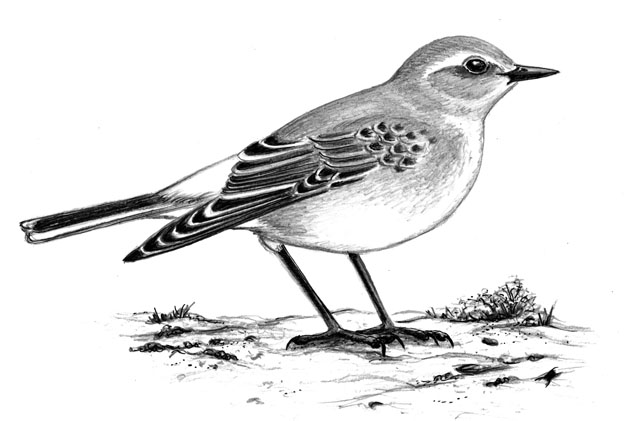
Dear Bird Folks,
I was walking along Skaket Beach in Orleans (MA) yesterday, when I came upon a group of birders who were taking photos of a bird. One of them even let me look at the bird through his scope. He said the bird was a “wheatear.” It’s a very cute bird, with an even cuter name, but I don’t think cuteness was the reason all the birders where there. What made this bird so special?
– Rachel, Plymouth, MA
You are right, Rachel,
When birders go out of their way to see a bird I don’t think “cuteness” is the motivating factor. Most often when birders gather in one spot it’s to see a rare bird and that is the case with the wheatear at Skatet Beach. (Caution: Skaket is pronounced Skay-kit, not Skack-it. And while we’re at it, the bird’s name is pronounced wheat-ear, not wheat-eater, or wheat-germ.) Seeing a wheatear around here is such a big deal that even I went to look for it. I usually don’t run out to see birds that others have reported. It’s not that I’m lazy (okay that’s part of it), but for me, knowing that a particular bird is going to be at a particular spot at a particular time is like knowing ahead of time what my Christmas gifts are going to be. It totally takes the fun out it. But when someone ran in to my shop to tell me that there was a “wheat-eater” on “Skack-it” Beach, I had to see it for myself.
It was late the day I went to look for the wheatear. The sun was starting to set and there were lots of people on the beach enjoying the end of a perfect Cape Cod day. The moment I stepped out of my car I started to laugh. What was so funny? On one part of the beach there were families running about, dressed in colorful outfits, designer jackets and funky hats. On another part of the beach there was a smaller group of less energetic people, all standing perfectly still and dressed in apparel from the army surplus store. They looked like refugees from the old East Germany. These people were my fellow birders and I knew exactly which part of the beach had the wheatear, because folks dressed in army surplus clothing have never steered me wrong. Two minutes later I saw the bird.
Last week I wrote about birds that have come down from Canada to find food. The Northern Wheatear is not one of those birds. Oh, it has come down from Canada all right, but not to find food. In fact, it most likely doesn’t even want to be here. Wheatears breed in the extreme north. Their nests are found on the coast of Greenland, around Baffin Bay, and in parts of Canada that are so remote they haven’t even named them yet. While Orleans isn’t a bad place to spend the winter (although you wouldn’t know it by all the cowards who abandon us each fall), it is the last place this bird wants to be. It had a totally different destination in mind. Each fall Northern Wheatears – songbirds that are smaller than our Eastern Bluebirds – leave Canada and somehow fly the 2,100 miles across the North Atlantic to England. They then fly across the English Channel (however a few wealthy birds take the Chunnel). From there they go to Spain and eventually find their way to places like Ethiopia, Kenya and Timbuktu (really). And that’s where the bird on Skaket Beach should be right now.
There are about twenty species of wheatears found in the world, but the Northern Wheatear is the only one brave enough to make the long journey to North America each spring. They are complicated birds. Until recently, it was thought that wheatears were closely related to birds such as robins and thrushes. Most field guides, even the new ones, still claim that. But as with many things in life, stuff changes. (Remember, we used to think that Pluto was a planet, margarine was good for us and Zumba was an innocent dance.) Now it is thought that wheatears are actually related to Old World flycatchers. I know most people don’t care about that, but I felt obligated to mention it. But here’s some info that you’ll probably be glad to know. It’s about the bird’s name. The name “wheatear” sounds like a slang term for someone who works in health food store, but it’s actually more interesting than that. Wheatears typically have white patches on their rumps, so it is thought that their name comes from the corruption of the old English term, “white-arse.” How about that? Now there’s information worth knowing.
For the most part, wheatears are easy birds to please. On their breeding grounds they thrive on barren, rocky tundra and in places where few other creatures could earn a living. On the rare occasions, like now, when one of these birds ventures into civilization, it’s likely to be found in equally ugly habitat. Stump dumps, construction sites and abandoned parking lots are prime real estate for lost wheatears. The bird that has settled on beautiful Skaket Beach must feel it has moved into the Ritz, only without the doorman and the outrageous mini-bar bill. How long this wheatear will stay around and where it will go from here is anyone’s guess, Rachel, but I’m glad you got to see it. I’d like to write a little more about this interesting bird, but I can’t do it right now. I’m already late for my Zumba lesson.